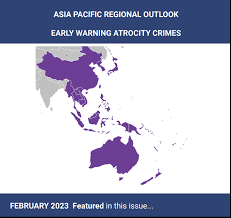
https://r2pasiapacific.org/article/2024/02/regional-outlook-february-2024
Countries at high risk of further atrocity crimes include China, Myanmar, and the Democratic People's Republic of Korea (DPRK). Countries at high risk include the Philippines and Papua New Guinea.
As well as examining individual countries, the Regional Outlook also summarises thematic issues in the region, namely sexual and gender-based violence, and the prevalence of disinformation, hate speech, and incitement.
The February 2024 edition of the Regional Outlook can be read here (PDF, 709KB), or from our Regional Outlooks page, along with previous editions and smaller sections detailing select countries.
Our Mission
The mission of the Asia Pacific Centre for the Responsibility to Protect (the Centre or APR2P) is to deepen knowledge and advance policy on the Responsibility to Protect (R2P) principle, and facilitate effective prevention and response mechanisms to mass atrocities within the Asia Pacific region.
Launched in February 2008, the Centre is dedicated to achieving this mission through research and policy dialogue with our regional and international partners, with joint funding from The University of Queensland and the Australian Government's Department of Foreign Affairs and Trade.
Progress
The Centre has helped achieve significant progress in developing the region's normative consensus on R2P and in building partnerships and communities of practice across the region. Today, the Centre works with partners in almost every corner of the region, stretching from Myanmar to Japan, promoting R2P and facilitating national action to prevent atrocities. The Asia Pacific is a region engaged with R2P as exemplified by the highly successful regional conference held in Cambodia to mark the tenth anniversary of R2P in 2015. The Centre has also promoted the implementation of atrocity prevention through regional action, such as the Council for Security Cooperation in the Asia Pacific's (CSCAP) Study Group on R2P and the High Level Advisory Panel on the Responsibility to Protect in Southeast Asia.









